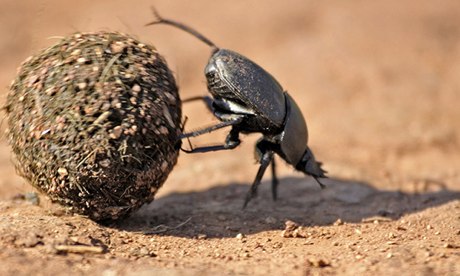
An unusual line-up of stars will make their names on television next year. They include the gigantopithecus, a huge extinct ape – resurrected through the wonders of CGI – which will frolic in 3D with David Attenborough in Sky's Natural History Museum Alive.
The south-east Asian tree shrew and the dung beetle will bear testimony to the hardships that the world's tiniest animals endure, in BBC1's Hidden Kingdoms, while Dolphins: Spy in the Pod, also on BBC1, will reveal the intimate lives of wild cetaceans through the use of cameras fitted to robot fish.
It promises to be a year of delights for fans of natural history programmes. Indeed, TV schedules indicate that 2014 will be unsurpassed for wildlife documentaries. In shoals, herds and swarms, the planet's birds, fish and animals will fill our screens to fulfil the demands of viewers from across the globe who want their screens filled with visions of the natural world, programmes provided not only by the BBC and Sky but by channels such as Discover and National Geographic.
The reason for this mounting popularity is not hard to fathom, Attenborough told the Observer: "These programmes are always beautiful. They contain so much that is unexpected. They are not trying to sell you anything and the makers do not want your vote."
Not a bad formula. But there are other reasons to explain the soaring popularity of the wildlife documentary. For a start, there is the technology involved in watching and making these programmes. This continues to improve at a striking rate – from colour TV to giant 50in screens that can show HD images, and from miniaturised cameras and lenses to devices like the heligimbal camera which allows cameramen to take vibration-free images from the air and which was first used to stunning effect in the BBC's Planet Earth series.
"It is not just that these innovations helped make better wildlife documentaries," said Kim Shillinglaw, the BBC's head of commissioning for natural history and science. "It was the demands of the natural history programme-makers, trying to meet viewers' wishes, that drove the development of these techniques in the first place."
Future innovations will include improvements in high-definition filming – known as 4K TV – that will bring unprecedented clarity and texture to images, while 3D television will continue to enhance the experience of immersing the viewer in a programme. Apart from his Natural History Museum Alive show, which will recreate extinct exhibits using CGI, Attenborough will make another venture into 3D television next year with a two-part series on Sky, called The Conquest of the Skies. The programme will reveal how the first birds and the first flying insects, mammals and reptiles evolved.
It will be breathtaking stuff, promised Celia Taylor, head of factual and features for Sky, although she insisted that there was more to the success of natural history TV than the development of hi-tech cameras and huge television screens.
"Unlike every other form of programming, wildlife shows are multigenerational," Taylor said. "A five-year-old and a 95-year-old can sit down an enjoy them with the rest of the family."
Nor is this appeal confined to the west. Natural history programmes are becoming increasingly popular in Asia and China. "More and more people are living in cities, and there is a growing feeling among many that they have become disconnected with nature," said Shillinglaw. "Wildlife programmes help to put that right. And, of course, that is good for the BBC because it creates a wider export market for our shows and gives us the means to make more ambitious programmes."
An example is provided by Spy in the Pod, to be narrated by David Tennant and which will be shown in January. A total of 13 remote-control devices shaped like turtles, tuna, clams and squid were used to film dolphins off the coast of Mozambique. The results are striking. In one sequence a male bottlenose dolphin is seen wooing his sweetheart with a garland of seaweed. She plays coquettishly with her gift, like a feather boa, before their love is sealed by mating. In contrast Hidden Kingdoms, to be narrated by Stephen Fry, will be more stage-managed. In one scene a mouse is seen leaping to escape the jaws of a rattlesnake – a shot created by filming rattlesnakes striking at a towel and merging it with footage of the mouse. Viewers will be warned that the programme includes "dramatised natural history".
"There are many different genres that we can adopt to attract different audiences when making a wildlife programme," said Wendy Darke, head of the BBC's natural history unit, where most of the corporation's great wildlife series have been made and which has more than 50 crews working on programmes at any one time.
"We did a series called Deadly Sixty in which presenter Steve Backshall attempted to find the world's deadliest 60 animals and that proved popular with people who watch Top Gear but who were not typical wildlife fans. Similarly, Hidden Kingdoms will bring a bit of domestic drama to the genre.
"However, there is nothing like a 50in TV screen to bring a real spectacle into your front room. Every type of programme is enhanced by that kind of technology, but wildlife programmes get the greatest benefit."

